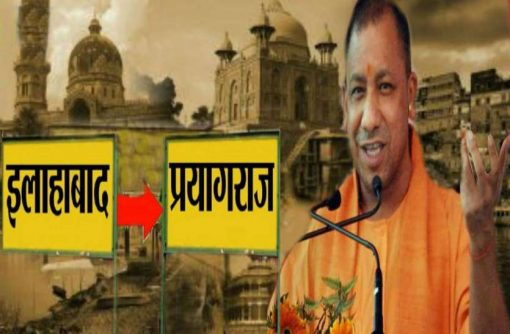
On 4 November, the second day of the Gyan Kumbh, Yogi Adityanath defended changing the name of Allahabad to Prayagraj. ANI quoted Adityanath saying, “When I changed the name of Allahabad, some people raised questions over it. Some also said, what is there in the name. So, I said, why didn’t their parents name them “Raavan” and “Duryodhan”? In this country, the name holds a lot of significance. In this country, most names are related to Ram’s and among Scheduled Castes, most people have attached Ram with their names. This name connects us with our glorious tradition.”
Some of the claims made by Adityanath, however, are not completely true. Pramod Ranjan, the Managing Editor of the Forward Press, a leading online platform for Bahujan culture, said the name Rama that Scheduled Castes use is the Rama that is present in the dohas of Kabir and Raidas, the medieval Bhakti poets who were critical of the Brahmins of their time. In an email interview with the Indian Cultural Forum he also responded to the Uttar Pradesh Chief Minister’s announcement of building a grand statue of Rama, “Yes, many Scheduled Castes use the word “Ram”, but Yogi Adityanath should know that the idol he wants to set up is not that of the Ram Tulsidas has written about. That virtuous Ram belongs to Kabir and Raidas. Their Ram says, ‘Jaati paati pooche nahin koi, hari ko bhaje sau hari ka hoyi’, whereas, Tulsidas’ Ram says, ‘Dhol, ganwaar, Shudra, pashu, naari sakal taadna ke adhikari.’”
Arvind Krishna Mehrotra, the translator of Kabir’s dohas into English, in an interview published in Guftugu, said that Kabir was critical of religious orthodoxy of any kind, whether it’s Hindu or Muslim. One of the dohas and its translation by Mehrotra, published in the same journal, shows Kabir’s criticism of caste. He says that the lower castes don’t have Rama in their lips:
जौ पै करता बरन बिचारै।
तौं जनतैं तीनि डांड़ि किन सारै ।।टेक।।
जे तूं बाभन बभनीं जाया।तौ आंन बाट होइ काहे न आया ।।
जे तूं तुरूक तुरुकिनीं जाया।तौ भीतरि खतनां क्यूं न कराया ।।
कहै कबीर मद्धिम नहिं कोई।सो मद्धिम जा मुखि रांम न होइ ।।
Were the Creator
Concerned about caste,
We’d arrive in the world
With a caste mark on the forehead.
If you say you’re a Brahmin
Born of a mother who’s a Brahmin,
Was there a special canal
Through which you were born?
And if you say you’re a Turk
And your mother’s a Turk,
Why weren’t you circumcised
Before birth?
Nobody’s lower caste;
The lower castes are everywhere.
They’re the ones
Who don’t have Rama on their lips,
Kabir says.
Duryodhan and Raavan are antagonists in Indian epics, but Ranjan, also the editor of a book on mahishasur, said that these supposed “antagonists” are worshipped and revered in certain tribal cultures. He said, “A large section of the Indian Adivasis considers Ravan, Mahishasur and Meghnath to be their ancestors and worship them. The Ravan of Gond Adivasis, Raaven as they call him, is their ancestor. He holds a very respectable position in their poonem darshan according to which, the entire Gond community is a descendant of Dai-Daau Shakti (male-female power), Faraaven Sailaangra’s son, Raven Periyol. The culture that people like Yogi Adityanath talk about is defined by an upper caste mindset. If they really understood or accepted Indian culture, they would never insult Adivasi or Dalit traditions like they do.”
On the other hand, The Statesman quoted senior Cabinet minister Siddhartha Nath Singh telling reporters, “Rig Veda, Mahabharat and Ramayana also mention Prayagraj (for Allahabad).” Herambh Chaturvedi, former Head at the Department of History, Allahabad University has drawn a distinction between “Prayagraj” and “Prayag”, and written in an article, “‘Prayag’ (not Prayagraj) was the earliest site of Brahma’s sacrificial altar – thus it was so named, according to Sanskrit etymology!”
“Raj” has been used to refer to the dead river Saraswati. The Times of India quoted Adityanath saying, “Prayag is a confluence of two rivers. Here we have a confluence of three rivers Ganga, Yamuna and Saraswati. Therefore its name will be Prayagraj.” The fascination with the river Saraswati has had real implications on the common taxpayer. After the BJP government came into power at the centre in 2014, the state government of Haryana has been trying to excavate the dead river. D Raghunandan, Director of the Centre for Technology and Development and a member of the Delhi Science Forum, said in an email interview with the Indian Cultural Forum, “The entire effort to “identify”, “locate” and finally “recreate” the legendary Saraswati river is completely non-scientific, and is entirely based on references in mythology and supposed astrological correlations. The taxpayers’ money is being drained in numerous similar ways. They are all intended to convert mythology into history, and make new mythologies. Take the Sardar Patel statue for instance. Close to 3000 crores have been spent for it.”




